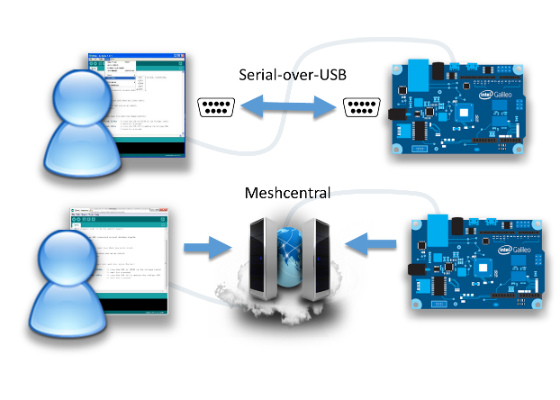Spotlight on Intel Galileo and Intel Edison Development Boards

There are a lot of boards out there for your Internet of Things (IoT) project. Choosing the right one is a matter of what you want to accomplish. You need to consider cost, power consumption, time to market, how long will your device be in the market, and the software tools you want to use.
Intel offers two development boards for IoT: Intel® Galileo and Intel® Edison platforms. Both are excellent building blocks for IoT devices. Think of them as very small motherboards with all the power of Intel® processors and a variety of expansion opportunities. Plus, they both run Linux*, so you can access and tweak every aspect of the underlying hardware.
Let’s take a closer look at what Intel® Galileo and Intel® Edison have to offer.
Intel® Galileo – Your Prototyping Powerhouse
The Intel® Galileo Gen 2 development board is a powerful prototyping tool, suitable for a wide range of projects. Unlike many other IoT-focused boards, Intel® Galileo technology has the power to handle multiple tasks, making it ideal for those more complex projects. For instance, if you’re developing for a conference room, and you want to turn off the lights, power down the projector, and shut off the PC, Intel® Galileo is the board for the job.
What makes it so powerful? Take a look at these Intel® Galileo specs:
- Intel® Quark™ SoC X1000 application processor
- 256 MB RAM
- 8 MB flash
- Multiple industry-standard I/O interfaces, including:
- Mini-PCI Express* slot
- 100 Mb Ethernet port
- microSD* slot with support for up to 32 GB additional storage
- USB host port
- USB client port
- Arduino* compatibility
- Support for Yocto 1.4 Poky* Linux*
- Support for multiple development platforms
It’s like a mini PC! Because it has a range of connectivity options, Intel® Galileo technology is great for environments where Internet access is a challenge. For instance, for a rural application where broadband is lacking, you can plug in a 3G module. In a factory where Wi-Fi* is spotty, the Ethernet port saves the day.
Intel® Edison – Quick Prototyping So You Can Get to Market (or Fun) Faster
The Intel® Edison board, on the other hand, is specifically designed for fast, inexpensive prototyping. Take a look at these features:
- 22 nm Intel® Atom™ SoC
- 1 GB RAM
- 4 GB flash storage
- Wi-Fi*
- Bluetooth Low-Energy (LE)*
- Integrated power management
- Less than 1 W of power when fully operating
- USB ports
- 40 multiplexed GPIO interfaces, perfect for connecting a sensors, a small LCD screen, and a variety of expansion boards
All this on a board that’s not much larger than a postage stamp!
If you need something low cost, really tiny, and totally wireless that uses very little power, the Intel® Edison is a great place to start. No wonder it’s the board of choice for many tech-couture projects, such as Dutch fashion tech designer Anouk Wipprecht’s futuresque Synapse* dress, which uses a variety of sensors to identify the wearer’s state of mind and then displays it on her body.
The most high-profile Intel® Edison project of late may be Nixie*, a wearable selfie drone introduced at CES*. Worn on the wrist, the Nixie* can be easily removed and tossed into the air, where it snaps a photo and then flies back to you. Christoph Kohstall and Jelena Jovanovic developed the device as part of the Intel® Make it Wearable challenge. Prototyped on an Intel® Edison board, Nixie* is now in development as a consumer product.
To use an Intel® Edison board, you’ll need one or more expansion boards—and there are plenty of options out there. SparkFun* offers a series of stackable, single-function boards, called Blocks, that can be connected to your Intel® Edison board to create a small, sturdy stack that meets your specific project’s needs. For instance, you can add a battery, console connectivity, additional GPIO ports, and more without changing the footprint of your device. With a powerful processor and multitude of expansion opportunities, an Intel® Galileo or Intel® Edison board may be just the right component to get your IoT project off the ground. So, what will you make?
Intel® Developer Zone for IoT
Start inventing today with the Intel® IoT Developer Program, which offers knowledge, tools, and experts to turn your innovative ideas into IoT solutions.
Dream it, build it with the Intel® IoT Developer Kit for the Intel® Edison and Intel® Galileo platforms. With easy-to-use hardware, software, tools, and cloud services, it delivers usability improvements and faster start to development times.
For more resources and to learn how the new Intel® IoT Developer Kit v1.0 can help streamline your IoT projects:
- Download the Intel® IoT Developer Kit
- Visit the Intel® Developer Zone for IoT
- Attend one of our roadshows for hands-on training in creating your own IoT projects
For more such intel IoT resources and tools from Intel, please visit the Intel® Developer Zone
Source: https://software.intel.com/en-us/articles/spotlight-on-intel-galileo-and-intel-edison-development-boards/




